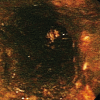Black esophagus: acute esophageal necrosis syndrome
- PMID: 20614476
- PMCID: PMC2900712
- DOI: 10.3748/wjg.v16.i26.3219
Black esophagus: acute esophageal necrosis syndrome
Abstract
Acute esophageal necrosis (AEN), commonly referred to as "black esophagus", is a rare clinical entity arising from a combination of ischemic insult seen in hemodynamic compromise and low-flow states, corrosive injury from gastric contents in the setting of esophago-gastroparesis and gastric outlet obstruction, and decreased function of mucosal barrier systems and reparative mechanisms present in malnourished and debilitated physical states. AEN may arise in the setting of multiorgan dysfunction, hypoperfusion, vasculopathy, sepsis, diabetic ketoacidosis, alcohol intoxication, gastric volvulus, traumatic transection of the thoracic aorta, thromboembolic phenomena, and malignancy. Clinical presentation is remarkable for upper gastrointestinal bleeding. Notable symptoms may include epigastric/abdominal pain, vomiting, dysphagia, fever, nausea, and syncope. Associated laboratory findings may reflect anemia and leukocytosis. The hallmark of this syndrome is the development of diffuse circumferential black mucosal discoloration in the distal esophagus that may extend proximally to involve variable length of the organ. Classic "black esophagus" abruptly stops at the gastroesophageal junction. Biopsy is recommended but not required for the diagnosis. Histologically, necrotic debris, absence of viable squamous epithelium, and necrosis of esophageal mucosa, with possible involvement of submucosa and muscularis propria, are present. Classification of the disease spectrum is best described by a staging system. Treatment is directed at correcting coexisting clinical conditions, restoring hemodynamic stability, nil-per-os restriction, supportive red blood cell transfusion, and intravenous acid suppression with proton pump inhibitors. Complications include perforation with mediastinal infection/abscess, esophageal stricture and stenosis, superinfection, and death. A high mortality of 32% seen in the setting of AEN syndrome is usually related to the underlying medical co-morbidities and diseases.
Figures
References
-
- Gurvits GE, Shapsis A, Lau N, Gualtieri N, Robilotti JG. Acute esophageal necrosis: a rare syndrome. J Gastroenterol. 2007;42:29–38. - PubMed
-
- Goldenberg SP, Wain SL, Marignani P. Acute necrotizing esophagitis. Gastroenterology. 1990;98:493–496. - PubMed
-
- Le K, Ahmed A. Acute necrotizing esophagitis: case report and review of the literature. J La State Med Soc. 2007;159:330, 333–330, 338. - PubMed
-
- Lacy BE, Toor A, Bensen SP, Rothstein RI, Maheshwari Y. Acute esophageal necrosis: report of two cases and a review of the literature. Gastrointest Endosc. 1999;49:527–532. - PubMed
Publication types
MeSH terms
LinkOut - more resources
Full Text Sources
Medical
Miscellaneous


